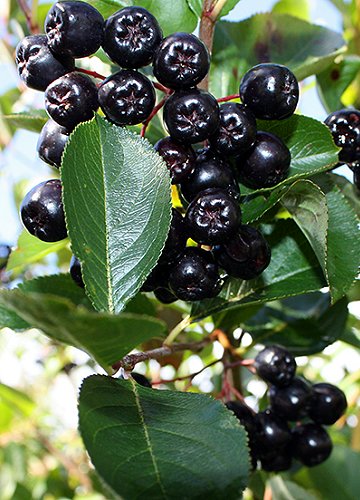
|
|
Maqui (Aristotelia chilensis).
Leaves and fruits.
|
Maqui - Aristotelia chilensis
Aristotelia chilensis (Maqui or Chilean wineberry) is a species of the Elaeocarpaceae family native to the Valdivian temperate rainforests of Chile and adjacent regions of southern
Argentina (Patagonia). Maqui is sparsely cultivated. The botanical name Aristotelia derived from Aristotle, ancient Greek naturalist and philosopher
Maqui is a small dioecious tree reaching 4–5 m in height and is evergreen. It
is growing at elevations up to 2,500 m. Its divided trunk has a smooth bark. The branches are abundant, thin and flexible. The leaves are simple, opposite, hanging, oval-lanceolate, with serrated edges, naked and coriaceous. The leaf venation is well visible and the leaf stalk is strong red. In the beginning of spring, the tree sheds the old cohort. The old cohort is used as a carbohydrate source to form the new leaves and
flowers.
It is in flower in May, and the seeds ripen from Aug to
September. The small white flowers are dioecious (individual flowers are either male or
female, but only one sex is to be found on any one plant so both male and female plants must be grown if seed is
required) and are pollinated by Bees, insects. The plant is not self-fertile. Flowers yield a small edible
fruit (berry). The berry is found only on the female
plant.The berries are harvested between December and March, depending on
latitude. It is among the first species to repopulate burned or deforested areas
A tree at the age of seven years produces up to 10 kg berries per year. The
small, purple-black berries are approximately 4–6 mm in diameter and contain 4-8 angled
seeds. With a taste similar to blackberries, maqui is also known as the Chilean
wineberry, and locally in Spanish as maqui or maque.
i
The main area of wild maqui can be found in the Chilean forests. It includes the Coquimbo and Aysen regions and is 170,000 hectares in total
area. The average area yield is about 220 kg per hectare annually, with estimated yield of only 90 tons due to its remote access and difficulty for
transportation
The berries are collected from December to March each year by families, mainly Mapuche who collect their harvest near the Andes
Mountains. The process involves collecting the side branches of trees, shaking them to separate the
berries, and then employing a mechanical process to separate berries from leaves.
Maqui berries are a favored food for birds at the end of summer. Deforestation of the Valdivian temperate rainforests in Chile suppresses seed dispersal by birds and leads to inbreeding
depression.
Maqui is planted in home gardens and is not grown on an orchard scale. Most of the fruits on the market come from the
wild. Maqui is frost sensitive and fairly tolerant of maritime exposure. It prefers a
well-drained soil in full sun with a protection against cold drying winds. The soil should be slightly acidic with moderate
fertility.
Maqui can be planted in USDA- zone 8 to 12. It is cultivated in Spain and in
milder, moister areas of Britain where winter frosts reduce plant stock, stimulating growth of more shoots in
spring.
The Maqui berries are richly colored, ranging from dark red to deep
purple. The taste is noted as pleasant, sweet, and dry like
bilberries. Maqui berries are used for food and dietary
supplements, mainly due to interest for color and anthocyanin content. The berries are
raw, dried or processed into jam, juice, an astringent or as an ingredient in processed foods or
beverages. The rich color is attributed to anthocyanins, a powerful
antioxidant. The fruit’s pigments are sometimes used to improve the color of red wines and as organic food
colorants.
Only limited polyphenol research has been completed on the maqui berry showing its anthocyanin content to include eight glucoside pigments of delphinidin and cyanidin, the principal anthocyanin being delphinidin 3-sambubioside-5-glucoside (34% of total anthocyanins). One study found that anthocyanins are also present in maqui leaves. Maqui fruit, when frozen, maintains its anthocyanin content and actually shows an increase in polyphenols. The highest antioxidant concentration is found in the flesh of the fruit. Both the berry and the leaf have medicinal constituents.
The edible fruit was eaten by the Mapuche Indians.
The Maqui tree is sacred to the indigenous Mapuche Indians, who consider the plant a symbol of goodwill and peaceful intention. Historically, the Mapuche created both fresh and fermented Maqui beverages that their warriors drank daily to instill strength and stamina. Notably, unlike most other tribes of the American continents, the Mapuche successfully and repeatedly defended their society from European conquest. Spanish Conquistadores noted that the Mapuche ate little solid food, but drank the Maqui beverages (called “chicha”), suggesting that their remarkable presence in battle was attributable to their unique diet. Maqui berry is a food product for some modern Chileans, who consume it fresh or dehydrated, or in the form of liquors, teas, juices, and jams.
As an external medicine, the Mapuche used the dried leaves and berries for healing infected wounds and for scarring injuries. Poultices of the leaves were used for anti-tumor, analgesic, and anti-pyretic properties. Internally, water infusions of the leaves and berries were used for antidiarrheal, digestive and intestinal uses, kidney pains, and as an anti-inflammatory. A gargle of the leaf infusion was used for ulcers of the mouth and throat, as well as for tonsillitis.
Source:
https://en.wikipedia.org/wiki/Aristotelia_chilensis
http://www.pfaf.org/user/Plant.aspx?LatinName=Aristotelia+chilensis
http://medicinalherbals.net/maqui-berry-aristotelia-chilensis-superfruit/
